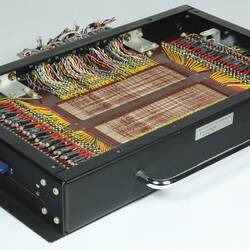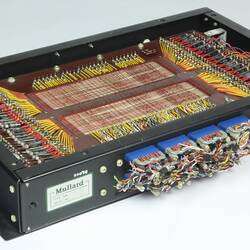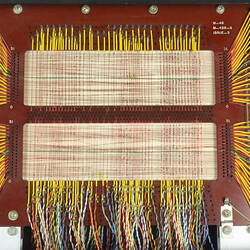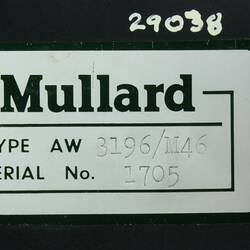Summary
Ferrite bead core memory from a LEO 3 Model, manufactured by International Computers Limited (I.C.L.). Previous Leo models used delay line memory.
Ferrite core memory is a form of Random Access Memory (RAM0 is used for read/write data storage. It was system developed at Massachusetts Institute of Technology (MIT) by Jay Forrester in 1951
The core is made of tiny ferrite rings, threaded with wires. The cores can be magnetised in two ways to represent the binary values zero and one. Data are stored as a combination of zeros and ones. This form of memory storage began in the 1950s and was widely used up through the 1970s. Core memory, which made forms of memory such as the magnetic drum obsolete, was rendered obsolete by semiconductor memory.
Physical Description
Black metal case enclosing circuit board with two rectangular cutouts. Each cutout is spanned by two sets of parallel wires arranged so that one set is at right angles to the other set. At some locations where a pair of wires cross the wires thread through, and are linked by, a small ferrite ring. A chrome-finish handle is attched to the front of the case.
More Information
-
Collecting Areas
-
Acquisition Information
Purchase
-
Manufacturer
International Computers Limited (I. C. L.), England, Great Britain, circa 1968
See references for justification of date. -
Inscriptions
On plate screwed to front of case: English Electric - LEO computers Ltd. / Unit No. M-46 / Serial No. 23 On label attached to back of case: Mullard / TYPE AW 3196/M46 / SERIAL No. 1705
-
Classification
-
Category
-
Discipline
-
Type of item
-
Overall Dimensions
415 mm (Length), 320 mm (Width), 63 mm (Height)
-
References
Extract from ANSWERS LEO. Accessed 16 May 2013. [Link 1] 'In 1954, with the decision to proceed with LEO II and interest from other commercial companies, Lyons formed LEO Computers Ltd. The first LEO III was completed in 1961. English Electric LEO Computers, later English Electric Leo Marconi (EELM), eventually merged with International Computers and Tabulators (ICT) and others to form International Computers Limited (ICL) in 1968.' Core memory definition from Webopedia. Acecessed 16 May 2013. [Link 2] Core Memory. Accessed 26 April 2013. [Link 3]
-
Keywords
Computer Components, Computer Memory Devices, Computers, Computing





